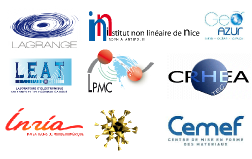Room-Temperature Polaritonics Based In ZnO
Semiconductor planar microcavities operating in the strong-coupling regime, i.e. optical resonators in which the eigenmodes of the system are no longer purely excitonic nor purely photonic but a mixture them, have seen a rapid development in the last years especially since the demonstration of polariton Bose-Einstein condensation. The numerous and exciting discoveries that have followed, including superfluidity and topological defects generation, have been possible thanks to a mature fabrication technology of distributed Bragg reflectors (DBRs) and semiconductor heterostructures, mainly based in GaAs and CdTe. This evolution has finally led to polariton manipulation. However, all these experiments were carried out at low temperatures because, even if the strong-coupling regime can be kept up to room-temperature in those systems, their limited exciton stability at high temperatures and large particle density precluded condensation at room-temperature (RT).
If polariton condensation wants to be obtained at high temperature, i.e. RT or above, materials with large oscillator strengths and large exciton binding energies must be employed. This is the reason why so much attention has been paid lately to organic semiconductors, GaN and ZnO.
In this talk, and after a brief overview of room-temperature polaritonics, we will describe the development of ZnO-based microcavities. It will be shown that two basic types of planar microcavities can be conceived containing either two dielectric DBRs or a combination of an epitaxial and a dielectric DBR. Such kind of cavities can display RT polariton condensation (i.e. the polariton lasing transition), as accompanied by: an increase of the output intensity by more than two orders of magnitude, a reduction of the emission linewidth below that of the bare-cavity mode, and a relatively small blueshift of the lower polariton branch (less than 10% of the Rabi splitting). This last feature is especially important since it assures that the lasing transition occurs within the strong-coupling regime. Next, we will illustrate how the matter/light content of polaritons can determine their relaxation kinetics from the exciton reservoir down to the bottom of the lower polariton branch, where they can eventually condensate, as well as the physical properties of the associated condensates (in particular their propagation characteristics).
Finally, we will discuss prospective applications of these cavities as well as the possibility of integrating them into more complex platforms combining several functionalities.
